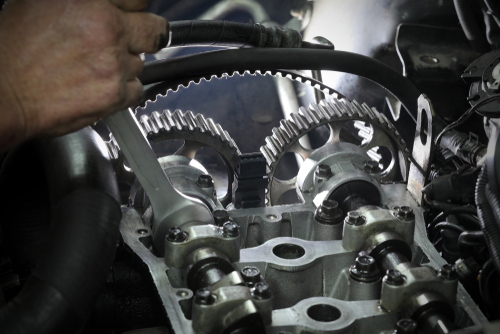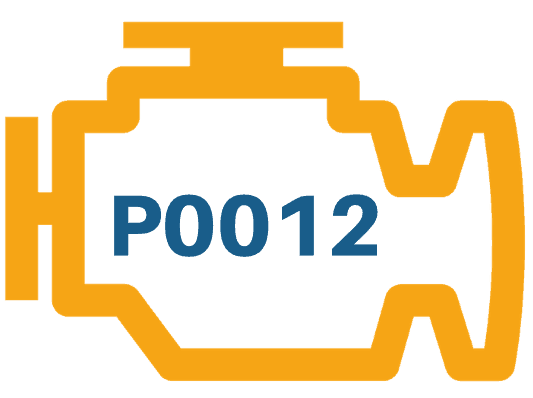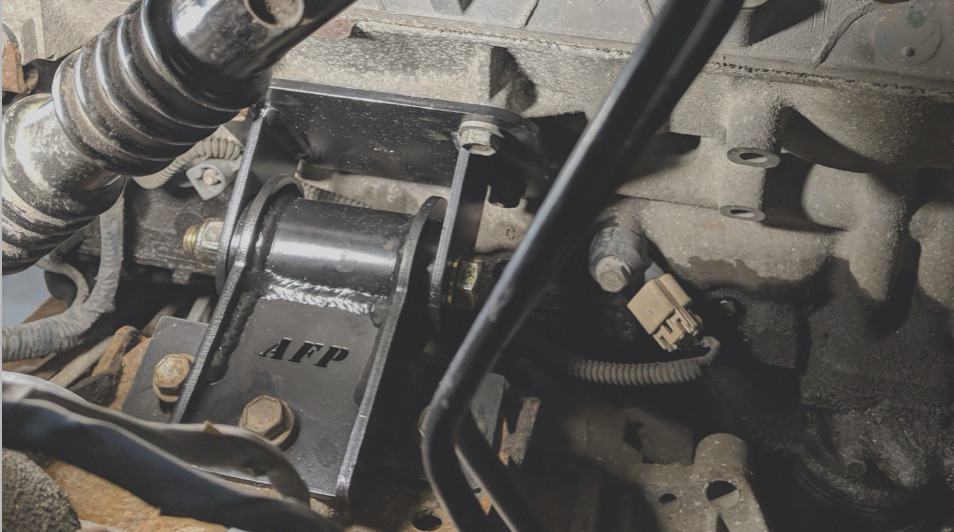Have you ever been cruising along when suddenly your check engine light starts flashing like a disco ball? It might be your car’s way of telling you about P0012, a diagnostic trouble code that’s all about timing – and not the kind that helps you catch the green light.

P0012 indicates that the intake camshaft timing on Bank 1 of your engine is more retarded than your car’s computer wants it to be. In simpler terms, it’s like your engine’s internal clock is running a bit slow, and your car isn’t happy about it.
This timing mishap can throw off your engine’s groove, leading to a symphony of issues from poor performance to increased fuel consumption.
Don’t worry though, you’re not alone in this timing tango. Many drivers face this camshaft conundrum, and with a little know-how, you can get your engine’s rhythm back on beat.
Let’s dive into what P0012 means for your ride and how you can get it fixed faster than you can say “variable valve timing.”
Key Takeaways
- P0012 indicates your engine’s intake camshaft timing is off, potentially affecting performance and fuel efficiency
- Common symptoms include rough idling, decreased power, and increased fuel consumption
- Proper diagnosis and timely repairs can prevent more serious engine damage and restore optimal performance
Understanding P0012
The P0012 code signals a timing issue with your engine’s camshaft. It’s like your car’s heart is beating out of sync, and that’s not good for its health or performance.
What Is P0012?
P0012 is a diagnostic trouble code that pops up when your car’s computer detects the intake camshaft on Bank 1 is lagging behind. Think of it as your engine’s rhythm section being a beat too slow.
This code specifically points to the “A” camshaft, which is typically the intake camshaft. When it says “over-retarded,” it means the camshaft is moving slower than it should.
Bank 1, in case you’re wondering, is usually the side of the engine with cylinder #1. So, if your mechanic starts talking about Bank 1, you’ll know they’re not referring to your finances!
The Role of Variable Valve Timing
Variable Valve Timing (VVT) is like the conductor of your engine’s orchestra. It adjusts the timing of your engine’s valves to optimize performance, fuel efficiency, and emissions.
When P0012 shows up, it’s saying your VVT system is having a bit of stage fright. The intake camshaft isn’t advancing or retarding as it should, throwing off the whole performance.
This timing mishap can lead to poor fuel economy, reduced engine power, and even that dreaded “Check Engine” light. It’s like your car is trying to run a marathon with one shoe tied too loose!
Symptoms and Detection

When your engine’s timing is off, it can really throw a wrench in your day. Let’s take a look at how you might spot this pesky P0012 code and what your car’s brain is doing behind the scenes.
Common Symptoms of P0012
You might notice your trusty steed isn’t running as smoothly as it used to. Engine misfires are a common sign – it’s like your car has the hiccups.
Your idle might get rougher than a cowboy’s beard, and in severe cases, your engine could stall faster than your excuses for being late to work.
Keep an eye out for that dreaded Check Engine Light. It’s like your car’s way of saying, “Hey buddy, we need to talk.”
You might also see the “Service Engine Soon” light, which is just a fancier way of saying the same thing.
Your fuel economy might take a hit too. It’s like your car suddenly developed an expensive drinking habit.
How the ECM Detects P0012
Your car’s Engine Control Module (ECM) is like a helicopter parent for your engine. It’s constantly monitoring the camshaft position sensor signals.
When it notices the intake camshaft is lagging behind where it should be, it throws a fit – aka the P0012 code.
The ECM compares the actual camshaft position to what it expects based on the crankshaft position. If the timing is off by more than a few degrees for too long, it’s P0012 time.
It’s like your ECM is a strict teacher and your camshaft just showed up late to class.
This detection happens in real-time, so your ECM can catch issues before they turn into major problems. It’s looking out for you, even if it means ruining your day with a warning light.
Potential Causes and Diagnostics

The P0012 code can be a real head-scratcher, but don’t worry – we’ll break it down for you. This pesky problem usually stems from a few key culprits, and with the right approach, you can get to the bottom of it.
Probable Causes for Trouble Code P0012
Your engine might be throwing this code for a few reasons. First up, low oil pressure could be the villain. It’s like trying to run a marathon without your morning coffee – things just don’t work right.
Next on the list? A faulty oil control valve. This little gizmo is crucial for your camshaft timing, and when it goes wonky, your engine gets confused.
Don’t forget about the timing chain. If it’s stretched out like an old pair of sweatpants, it can mess up your camshaft timing something fierce.
Lastly, a misbehaving camshaft position sensor might be feeding your ECM some bad info. It’s like having a GPS that thinks you’re in Timbuktu when you’re actually in Toledo.
Steps for Diagnosing the P0012 Code
Time to put on your detective hat! First things first, grab your trusty scan tool. It’s like a doctor’s stethoscope for your car.
Next, check your engine oil level and quality. If it looks like muddy coffee, you’ve found your first clue.
Now, inspect that oil control valve. A quick visual check and electrical test can tell you if it’s playing nice.
Don’t forget to examine the timing chain. Look for any signs of wear or stretching. It should be tighter than your budget after a big repair bill.
Lastly, give that camshaft position sensor a once-over. Make sure it’s snug as a bug and sending the right signals.
Remember, diagnosing can be tricky. If you’re not comfortable poking around under the hood, there’s no shame in calling in the pros. Better safe than sorry, right?
The Repair Process
Fixing a P0012 code involves assessing the problem and deciding whether to tackle it yourself or seek professional help. Let’s break down the key steps and considerations to get your camshaft timing back on track.
Assessing Repair Importance and Difficulty
You’ll want to address this issue promptly, as over-retarded camshaft timing can lead to poor engine performance and potential damage. The repair difficulty varies depending on the root cause.
If it’s just a matter of changing your oil or replacing a Variable Camshaft Timing (VCT) solenoid, you might be able to handle it yourself with some basic tools and know-how.
But if you’re dealing with a worn timing chain or internal engine issues, you’re looking at a more complex job.
Always consult your vehicle-specific repair manual to gauge the complexity. It’ll give you a better idea of what you’re up against and help you decide if it’s within your DIY comfort zone.
DIY Vs. Professional Repairs
If you’re handy with a wrench and have some automotive experience, you might be tempted to tackle this repair yourself. Changing oil or replacing a VCT solenoid can save you some cash if you’re comfortable doing it.
But let’s be honest, sometimes it’s best to leave it to the pros. If you’re dealing with timing chain issues or internal engine problems, you’ll want to find a reputable auto repair shop.
They have the specialized tools and expertise to diagnose and fix complex camshaft timing issues.
Remember, labor rates can vary widely, so shop around. But don’t just go for the cheapest option – quality work is crucial when it comes to engine repairs. Your wallet might thank you now, but your engine could curse you later if the job’s not done right.
Maintaining Optimal Timing
Keeping your camshaft timing in check is like making sure your car’s heart beats in perfect rhythm. It’s crucial for your engine’s health and performance, so let’s dive into how you can keep that timing on point.
Preventative Maintenance Tips
First things first, change that oil regularly! Your Toyota Camry or RAV4 will thank you.
Clean oil keeps those VVT controllers happy and prevents that pesky P0012 code from popping up.
Don’t ignore those weird noises. If your engine starts sounding like a grumpy old man, it might be time for a timing chain check. Trust me, it’s cheaper than a new engine!
Keep an eye on your check engine light. If it starts flashing like a disco ball, get it checked pronto. It could be your camshaft timing waving a red flag.
Lastly, stick to your car’s maintenance schedule like it’s your favorite TV show. Regular tune-ups can catch timing issues before they become wallet-draining problems.
Benefits of Timely Camshaft Timing Maintenance
Let’s talk perks of keeping that timing in check. First off, your engine performance will be smoother than a buttered biscuit. No more timing over-retarded issues to slow you down!
Your fuel economy will improve too. Who doesn’t love saving a few bucks at the pump? It’s like finding money in your old jeans pocket, but every time you fill up.
Emissions? They’ll be lower than a limbo champion. Your car will be so green, trees might start high-fiving you as you drive by.
And let’s not forget about longevity. Keep that timing right, and your engine will be running strong long after you’ve forgotten where you parked it at the mall.
Frequently Asked Questions
Dealing with a P0012 code can be a real head-scratcher. Let’s tackle some common questions to help you get your ride back in tip-top shape without breaking the bank or your brain.
What’s the hit to my wallet gonna look like to correct a P0012 code?
Fixing a P0012 code can cost you anywhere from $100 to $1000. The price tag depends on what’s causing the trouble.
If it’s just a dirty oil issue, you might get off cheap. But if you’re looking at a worn timing chain, well, your wallet’s gonna feel that one.
Got a P0012 warning light, is it still safe to drive my car or am I tempting fate?
You’re playing with fire if you keep driving with that P0012 light on. It’s like ignoring a toothache – it’ll only get worse.
Your engine’s misfiring and running rough, which could leave you stranded or cause more damage. Best to get it checked out pronto.
Is there a DIY guide to fix camshaft position timing if it’s over-retarded?
Sure, you can tackle this yourself if you’re handy with a wrench. Start by checking and changing the oil.
If that doesn’t do the trick, you might need to replace the camshaft position sensor or the VVT solenoid. Just make sure you’ve got the right tools and a good repair manual before you dive in.
Are the causes for a P0012 code in a Toyota and a Ford the same or do they have different quirks?
Each car’s got its own personality, and that goes for P0012 codes too.
In a Toyota, it might mean the variable valve timing is acting up. For a Ford, you could be looking at a timing chain issue. Best to check your specific make and model to get the full scoop.
Does ‘over-retarded timing’ mean my car’s going slower than molasses in January, and how do I fix it?
“Over-retarded” doesn’t mean your car’s a slowpoke. It means the camshaft’s not in sync with the crankshaft.
You might notice poor acceleration or fuel economy. To fix it, start with the basics: check your oil and replace it if it’s dirty. If that doesn’t work, you might need to replace the VVT solenoid or timing chain.
What in tarnation could cause my car’s exhaust camshaft position to get all advanced on bank 1?
Well, if your exhaust camshaft’s getting ahead of itself, you’re looking at a different code altogether.
But for the intake camshaft being over-retarded, common culprits include low oil pressure, a faulty VVT solenoid, or a worn timing chain.
Keep an eye on your oil level and quality to prevent these issues.
